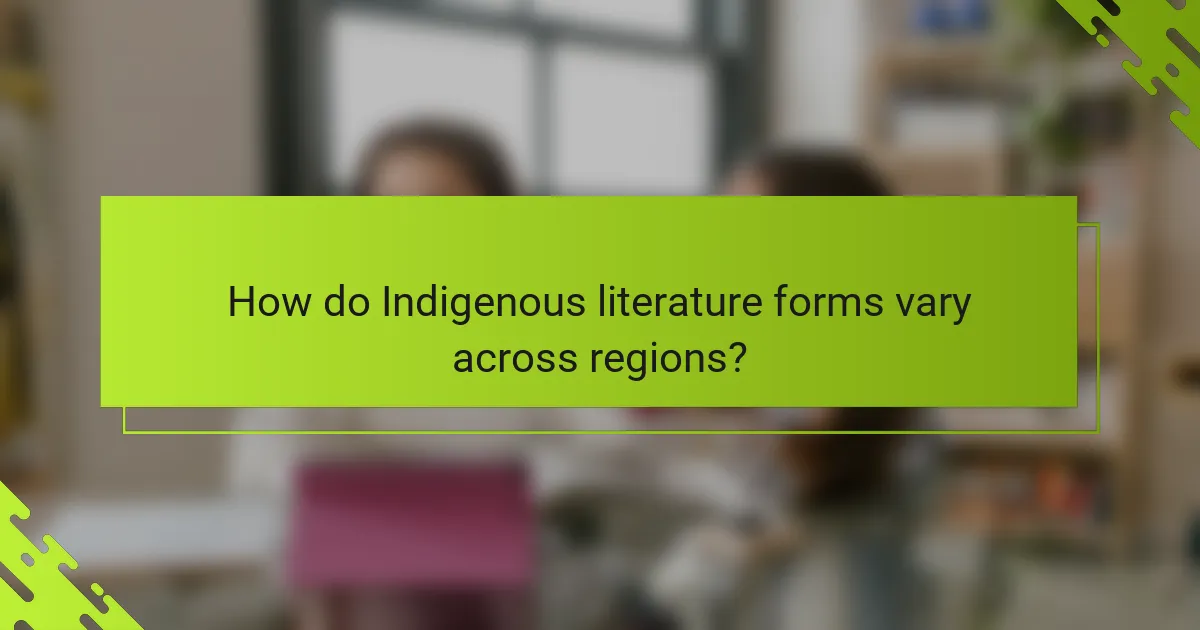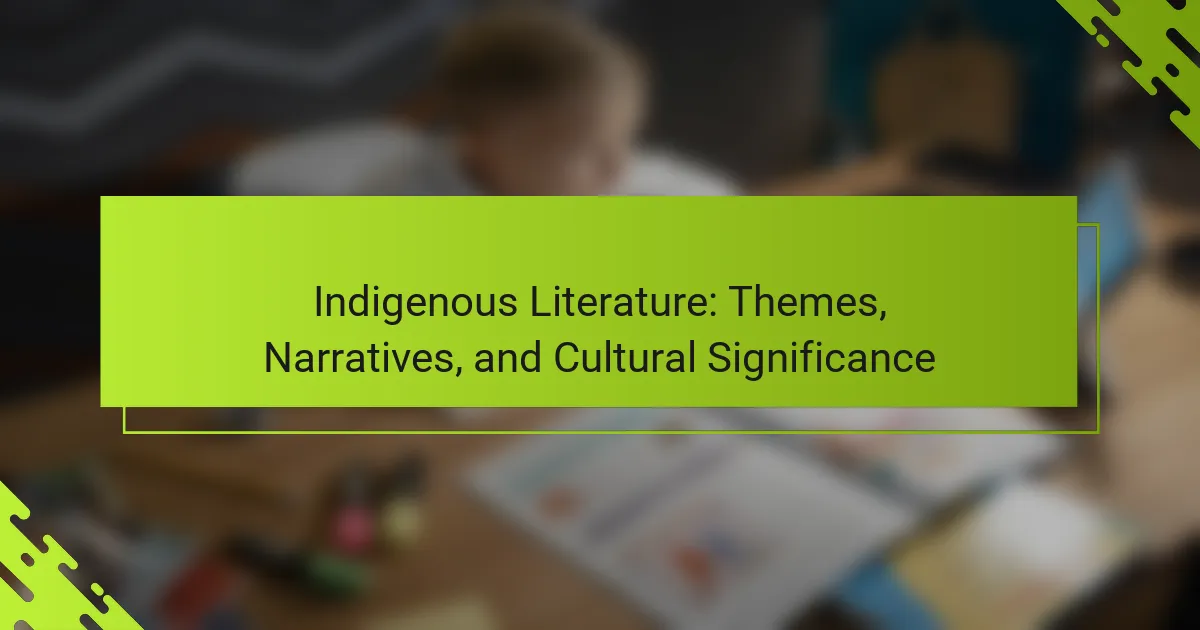Indigenous literature offers vital insights into the themes of identity, connection to land, and cultural resilience. It reflects unique narratives shaped by diverse cultural contexts and histories. This literature addresses social issues, highlights the impact of colonization, and emphasizes the importance of oral traditions. Recognizing the challenges faced by Indigenous authors enhances our understanding of their significant contributions to global literature.

What are the key themes in Indigenous literature?
Indigenous literature explores themes of identity, connection to land, and cultural resilience. These narratives often reflect the struggles and triumphs of Indigenous peoples, emphasizing their unique worldviews and histories. Key themes include the importance of oral traditions, spirituality, and the impact of colonization on Indigenous identities. The literature serves as a powerful medium for preserving cultural heritage and advocating for social justice.
How do cultural identity and heritage shape narratives?
Cultural identity and heritage profoundly shape narratives in Indigenous literature. They provide a framework for storytelling that reflects community values and historical experiences.
Indigenous narratives often emphasize themes of connection to land, ancestry, and spirituality. These elements serve as root attributes, grounding stories in cultural significance. Unique attributes, such as specific oral traditions or languages, further enrich the narratives, making them distinctive and reflective of individual tribes.
Moreover, the integration of historical events and contemporary issues creates a dialogue between past and present. This approach allows for a diverse exploration of identity and resilience, showcasing how heritage informs current realities.
As a result, Indigenous literature not only preserves cultural heritage but also fosters understanding and appreciation among wider audiences. This narrative approach highlights the importance of cultural identity in shaping stories that resonate across generations.
What role does storytelling play in Indigenous communities?
Storytelling plays a vital role in Indigenous communities by preserving culture and history. It fosters identity and strengthens community bonds. Oral traditions transmit knowledge, values, and teachings across generations. These narratives often reflect unique worldviews and experiences, emphasizing the connection to land and ancestors. Storytelling serves as a tool for cultural resilience, allowing Indigenous voices to reclaim their narratives in contemporary society.
Which environmental themes are prevalent in Indigenous works?
Indigenous works often emphasize themes of land, nature, and interconnectedness. These narratives reflect a deep respect for the environment and highlight the impact of colonization on Indigenous lands.
Common environmental themes include the sacredness of nature, the importance of sustainability, and the relationship between people and the earth. Indigenous literature frequently portrays the land as a living entity, integral to cultural identity and spiritual practices.
Additionally, the impact of climate change on traditional ways of life is a growing concern in contemporary Indigenous narratives. These works serve as a call to action, urging recognition and respect for Indigenous knowledge in environmental stewardship.
How is trauma and resilience depicted in Indigenous narratives?
Trauma and resilience are central themes in Indigenous narratives, often depicted through personal and collective experiences. These stories illustrate the impact of colonialism, displacement, and cultural loss, while simultaneously showcasing the strength and adaptability of Indigenous communities.
Indigenous literature frequently employs symbolism and oral traditions to convey the interconnectedness of trauma and healing. For example, stories may use natural elements, such as rivers or mountains, to represent the journey of overcoming adversity.
Resilience is portrayed not just as survival but as a dynamic process of cultural revitalization and community solidarity. Narratives emphasize the importance of storytelling as a means of preserving history and fostering identity, creating a space for healing and empowerment.
Through these narratives, Indigenous authors articulate a complex understanding of trauma, emphasizing both the pain of past experiences and the hope for future generations. This duality enriches the cultural significance of Indigenous literature, making it a powerful medium for expressing resilience.

How do Indigenous literature forms vary across regions?
Indigenous literature forms vary significantly across regions, reflecting diverse cultural contexts and histories. Each region’s literature incorporates unique themes, narratives, and storytelling techniques that convey the values and traditions of its people.
For example, Native American literature often emphasizes a deep connection to nature and spirituality, while Australian Aboriginal storytelling frequently includes Dreamtime narratives that explain creation and ancestral ties. In contrast, Indigenous literature in Canada may focus on themes of resilience and identity in the face of colonialism.
These variations highlight the unique attributes of each culture, showcasing how Indigenous literature serves as a vital expression of community identity and cultural preservation. The richness of these literary forms underscores their importance in understanding the broader human experience.
What are the characteristics of oral traditions in Indigenous cultures?
Oral traditions in Indigenous cultures are characterized by storytelling, communal participation, and cultural preservation. These traditions often feature unique narratives that convey moral lessons and historical knowledge. They rely on oral transmission, emphasizing memory and performance, which fosters a deep connection to identity and heritage. Additionally, oral traditions adapt over time, reflecting the community’s evolving experiences while maintaining core values.
Which written forms are most significant in Indigenous literature?
Significant written forms in Indigenous literature include oral traditions, storytelling, poetry, and novels. These forms express cultural values, history, and identity. Oral traditions preserve narratives that reflect community beliefs. Storytelling often employs metaphors and symbolism, connecting readers to Indigenous perspectives. Poetry captures emotional depth and cultural experiences. Novels explore contemporary issues while maintaining cultural relevance. Each form contributes uniquely to the richness of Indigenous literature.
How do contemporary Indigenous authors innovate traditional narratives?
Contemporary Indigenous authors innovate traditional narratives by blending cultural heritage with modern storytelling techniques. They incorporate diverse genres, multimedia elements, and personal experiences to create unique perspectives. This approach revitalizes Indigenous stories, making them relevant to contemporary audiences. As a result, these authors challenge stereotypes and promote cultural resilience. The fusion of tradition and innovation allows for a richer exploration of identity, community, and history in Indigenous literature.

What unique narratives emerge from specific Indigenous groups?
Unique narratives from specific Indigenous groups reflect their distinct cultural experiences and histories. For instance, the Navajo emphasize harmony with nature through stories that highlight balance and respect. The Inuit share narratives that convey survival skills in harsh climates, showcasing resilience and adaptability. The Lakota focus on communal values and spirituality, illustrating the importance of connection to land and ancestors. Each group’s literature serves as a vessel for preserving traditions and educating future generations about their unique worldviews.
How does the perspective of First Nations authors differ from Métis authors?
First Nations authors often emphasize collective identity and community narratives, while Métis authors focus on individual experiences and cultural hybridity. First Nations literature frequently explores themes of land, sovereignty, and historical trauma. In contrast, Métis literature highlights the blending of Indigenous and European cultures, showcasing unique perspectives. Both contribute significantly to Indigenous literature, yet their approaches differ in focus and thematic depth.
What distinctive storytelling techniques are used by Inuit writers?
Inuit writers employ distinctive storytelling techniques that reflect their cultural heritage and oral traditions. These techniques include the use of vivid imagery, symbolism, and a strong connection to nature.
Inuit narratives often incorporate traditional knowledge, emphasizing community values and shared experiences. The integration of oral storytelling elements is common, with a focus on rhythm and repetition, enhancing the narrative’s emotional impact.
Additionally, Inuit literature frequently features a non-linear narrative structure, allowing for a more immersive experience that mirrors the complexities of life in Arctic environments. This approach fosters a deep engagement with the themes of survival, identity, and resilience.

In what ways does Indigenous literature address social issues?
Indigenous literature addresses social issues by reflecting cultural identities, historical injustices, and contemporary challenges. These narratives often highlight themes of resilience, community, and the impact of colonization.
Through storytelling, Indigenous authors confront social issues such as land rights, identity, and systemic discrimination. For instance, novels like “The Round House” by Louise Erdrich explore the complexities of justice in Indigenous communities.
Moreover, poetry and oral traditions serve as powerful mediums for expressing social concerns and fostering understanding among diverse audiences. These works often aim to educate readers about the lived experiences of Indigenous peoples and promote social change.
In summary, Indigenous literature plays a crucial role in addressing social issues by weaving together cultural significance, personal narratives, and calls to action.
How does literature confront colonialism and its impacts?
Indigenous literature confronts colonialism by reclaiming narratives, preserving cultural identity, and critiquing colonial impacts. It often highlights the resilience of Indigenous communities and their connection to land and heritage. Through storytelling, authors challenge stereotypes and assert their perspectives, fostering understanding and empathy. This literature serves as a vital tool for cultural preservation and resistance against colonial narratives.
What is the significance of language preservation in Indigenous literature?
Language preservation in Indigenous literature is vital for maintaining cultural identity and heritage. It fosters a sense of belonging and continuity within Indigenous communities. By preserving their languages, these communities can transmit traditional knowledge, values, and stories, which are often embedded in their linguistic expressions. This preservation combats cultural erosion and promotes diversity in global literature. Furthermore, it enhances the understanding of Indigenous perspectives, enriching the literary landscape and contributing to broader discussions on cultural resilience and sustainability.

How is Indigenous literature received and recognized globally?
Indigenous literature is increasingly recognized and celebrated globally for its rich themes and cultural narratives. This literature often highlights unique perspectives on identity, land, and community, contributing to a broader understanding of diverse cultures. As a result, Indigenous authors have gained international acclaim, with works being translated and studied worldwide. The recognition of Indigenous literature promotes cultural preservation and fosters dialogue about social justice and historical narratives. Events like literary festivals and awards specifically honoring Indigenous voices further enhance visibility and appreciation.
What awards and honors highlight Indigenous literary contributions?
Indigenous literary contributions are recognized through various prestigious awards and honors. Notable examples include the Indigenous Voices Award, which celebrates Indigenous authors across genres, and the Governor General’s Literary Award, which often highlights Indigenous narratives. The Burt Award for First Nations, Métis, and Inuit Literature specifically honors works that reflect Indigenous experiences. Additionally, the Anisfield-Wolf Book Awards recognize literature that addresses issues of race and diversity, frequently including Indigenous authors. These awards underscore the cultural significance and thematic depth of Indigenous literature.
How do international readers engage with Indigenous texts?
International readers engage with Indigenous texts through cultural appreciation, critical analysis, and personal connection. They often seek to understand Indigenous perspectives and narratives, which may differ significantly from mainstream literature.
Readers are drawn to themes of identity, resilience, and connection to land, which resonate universally. The unique storytelling techniques used in Indigenous literature, such as oral traditions and non-linear narratives, offer fresh insights into human experience.
Engagement varies; some readers participate in discussions, while others may write critiques or share their interpretations. This interaction fosters a deeper understanding of the cultural significance embedded in these texts.
Overall, the engagement of international readers with Indigenous literature enriches both the readers and the broader discourse surrounding cultural narratives.

What are the challenges faced by Indigenous authors today?
Indigenous authors face numerous challenges today, including cultural misrepresentation, limited access to publishing resources, and systemic barriers. These obstacles hinder the visibility and recognition of their unique narratives and themes.
Cultural misrepresentation often leads to stereotypes, which can distort authentic Indigenous voices. Many Indigenous authors struggle against these portrayals, aiming to present their cultures accurately. Limited access to publishing resources restricts opportunities for Indigenous writers to share their stories widely.
Systemic barriers, such as lack of funding and support from mainstream literary institutions, further complicate the landscape for Indigenous literature. As a result, many authors are forced to navigate a predominantly non-Indigenous literary world that may not fully understand or appreciate their cultural significance.
How do issues of representation and authenticity affect Indigenous literature?
Issues of representation and authenticity significantly shape Indigenous literature. Authentic narratives reflect cultural truths and empower Indigenous voices. Misrepresentation can lead to stereotypes, undermining the complexity of Indigenous identities. Authenticity fosters connection and understanding, while inauthentic portrayals risk cultural erasure. Engaging with Indigenous authors ensures nuanced perspectives and preserves cultural heritage.
What barriers exist in publishing Indigenous works?
Barriers in publishing Indigenous works include limited access to mainstream publishing platforms, cultural misrepresentation, and lack of financial support. These challenges hinder the visibility and dissemination of Indigenous narratives. Additionally, there is often a disconnect between Indigenous authors and publishers, affecting the authenticity of the works. The unique attribute of Indigenous literature lies in its deep cultural significance, which is frequently overlooked in traditional publishing models.

What best practices can enhance the appreciation of Indigenous literature?
To enhance the appreciation of Indigenous literature, engage with its cultural contexts and narratives. Promote diverse voices through community events and workshops. Encourage interdisciplinary studies that connect Indigenous literature with history and social justice. Foster respectful dialogues that honor traditional storytelling methods. Provide educational resources that highlight Indigenous authors and their contributions.
How can educators integrate Indigenous literature into curricula effectively?
Educators can effectively integrate Indigenous literature into curricula by incorporating diverse narratives, themes, and cultural contexts. This approach fosters understanding and respect for Indigenous cultures.
1. Choose authentic Indigenous texts that reflect various perspectives and experiences.
2. Include discussions on themes such as identity, resilience, and connection to land.
3. Collaborate with Indigenous communities to ensure accurate representation and context.
4. Use interdisciplinary methods, connecting literature with history, art, and social studies.
5. Encourage critical thinking by analyzing the impact of colonization on Indigenous narratives.
6. Create a safe environment for students to engage in open discussions about cultural differences.
What strategies can readers use to deepen their understanding of Indigenous narratives?
Readers can deepen their understanding of Indigenous narratives by engaging with diverse perspectives and practices. First, explore primary texts by Indigenous authors to gain authentic insights. Next, participate in community events or workshops that highlight oral traditions and storytelling. Additionally, analyze historical contexts that influence contemporary narratives. Finally, seek out academic resources or courses focused on Indigenous studies to enrich comprehension and appreciation.
